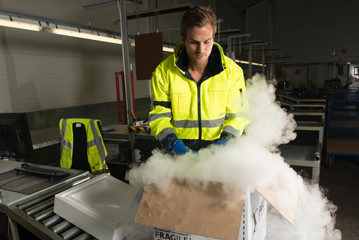
Visit Our Sponsors |
|
|
|
|
|
|
|
|
|
|
|
|
|
|
|
|
|
|
|
|
|
|
|
|
|
|
|
|
|
|
|
|
|
|
|
|
|
|
|
|
|
|
|
|
|
|
|
|
|
|
|
|
|
|
|
|

Biopharma is booming. With shipments set to reach $361 billion worldwide in 2019,1 the sector is growing at roughly twice the average industry rate. Already around half of all top 50 global drug products—about $260 billion of annual biopharma sales—are dependent on cold chain logistics. There is a lot at stake. Patient health depends on getting biopharma products in the right hands at the right time, and at the right temperature. That’s good for patients—and profits.
With the risks and rewards so high, companies are increasingly looking for the most effective temperature-sensitive shipping solutions to balance safety with efficiency. Your shipping strategy can be critical to the bottom line. And getting it right requires an intimate knowledge of cold chain logistics.
Here’s how cold chain expert Susan Li, a UPS senior cold chain packaging strategist, makes sure her customers’ biopharma products ship effectively, every time.
The International Trade Administration’s 2016 Top Markets Report2 highlights the risks involved in shipping temperature-sensitive products, stating “Each link in the cold chain must maintain the same level of integrity for the customer to receive a satisfactory product. A single breakdown in the chain can result in catastrophic losses.” In other words, a significant temperature excursion can mean the loss of valuable product.
What are the main risks? There are three big ones:
The weather is always important to shippers. Rain or shine, snow or hail, those are challenges that are well understood. For temperature-sensitive biopharma, however, the bar is quite a bit higher. Ambient temperature profiles—which comprise expected temperature data from key shipping lanes, based on previous measurements—are crucial to understanding the real impact of the shipping environment. UPS has invested heavily in understanding the enormous range of ambient temperature profiles. “We used data loggers to record temperatures during shipping journeys across 1.5 million package-miles,” says Li. “Our study encompassed 12 origins, more than 200 destinations, and two service levels in the United States alone. This gave us 270,000 data points—enough data points to create remarkably detailed and accurate ambient profiles.”
Importantly, ambient temperature profiles allow packaging experts to gauge the precise packaging requirements that will protect product throughout transit. This highly sophisticated dataset captures the real-world environmental conditions, which can vary tremendously by shipping lane and travel route, to determine the ambient temperature profile of a specific package. It allows UPS to design fully optimized temperature-sensitive packaging, and make recommendations for a particular product and route, and it gives customers the information they need make better decisions, taking costs and compliance into consideration, too.
Packaging is the first line of defense for fragile products. And biopharma is an exacting industry—one where the complexities of shipping has parallels with the challenges of developing the products in the first place. It is telling that 37 percent of healthcare logistics executives acknowledge that they are not successful when it comes to the challenge of product damage and spoilage,4 underlining the need for external expertise.
How do you know if your packaging is up to the job? Working with an expert to determine the optimal packaging design can be a smart move. UPS Temperature True® Packaging consultants, for example, can evaluate your existing packages for effectiveness by utilizing the testing services of the UPS Packaging Laboratory. They can also validate packaging against industry standards, and help negotiate pricing. From experience, they know that there is rarely a “one-size-fits-all” solution. Neither too little packaging, nor too much, is what makes an optimized packaging solution just right.
How efficient is your cold chain? Seven UPS healthcare logistics experts reveal best practices in this white paper, “Creating a Better Healthcare Cold Chain.”Download here
[1] Source: 2016 Top Markets Report: Cold Chain by the International Trade Administration p. 7 http://trade.gov/topmarkets/pdf/Cold_Chain_Executive_Summary.pdf. Original source: Pharmaceutical Commerce 2015; “The Cold Chain Directory2015: The 2015 Biopharma Cold Chain Landscape; http://pharmaceuticalcommerce.com/lib/sitefiles/pdf/Cold_Chain_Dir_2015.pdf
[2] Source: 2016 Top Markets Report: Cold Chain by the International Trade Administration p.3 http://trade.gov/topmarkets/pdf/Cold_Chain_Executive_Summary.pdf
[3] Source: 2016 Top Markets Report: Cold Chain by the International Trade Administration p. 7 http://trade.gov/topmarkets/pdf/Cold_Chain_Executive_Summary.pdf. Original source: International Air Transport Association 2016; Pharmaceutical Handling Presentation”; https://www.iata.org
[4] Eighth annual UPS Pain in the Chain Survey. www.ups.com/pitc
RELATED CONTENT
RELATED VIDEOS
Timely, incisive articles delivered directly to your inbox.







